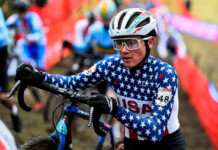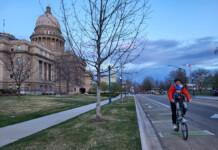By Dan Fazzini Jr., LCI, Chair, Salt Lake County Bicycle Advisory Committee
Urban Canyons are a great place to ride. They usually offer great scenery, generally slower motor vehicle traffic and are close to the areas which we live. The convenience of these canyons also comes with some tradeoffs.
Many hazards and challenges are presented to us when riding these canyons. Some have better shoulders than others, some are narrow, some are wide, some have rock fall and some have intermittent natural light.
Many modes of transportation are frequently used in these canyons. In addition to cyclists other users include: drivers in motor vehicles, runners, equestrians, hikers, motorcyclists, those just on a scenic drive, dogs and the occasional moose. In order for each user group to be safe, we must all respect each other’s right to use the roadway corridor in a safe and thoughtful manner.
Shoulder Use
Many canyons have a useable paved shoulder. The uphill cyclist should utilize these as much as possible (provided that the shoulder is reasonably free of debris and obstacles such as garbage cans, large rocks and parked cars). However, a cyclist should not ride so far to the right as to be “invisible” to residents pulling out of their driveways or being hidden around right bends to other drivers cutting over the fog line (white shoulder stripe).
Utah State Code 41-6a-1105 requires the cyclists to ride as far to the right as is “practicable,” gives some examples as to why the cyclist could or should move from that position, and when it is “legal” to ride two abreast.
Riding Two Abreast
For the purposes of riding in these canyons, law enforcement is currently including the shoulder when determining if riders are riding two abreast if at least one is in the traffic lane. To my knowledge, this has not yet been challenged in court. Their opinion is that if it is safe for the rider to ride in the shoulder, then the 2nd rider is unnecessarily “impeding the normal and reasonable movement of traffic.” For canyons such as Emigration Canyon in Salt Lake County, the County installed a widened shoulder striped on both sides of the shoulder which could be taken as being part of the “roadway.” There are arguments on both sides of this issue which we could discuss, but that is for another forum.
Due to increasing calls to the Sheriff’s office in Salt Lake regarding Emigration Canyon, by both motorists and cyclists, they are increasing their enforcement efforts and citations in the canyon. The Canyon Patrol Deputies will generally watch to see if you were just passing or having an extended conversation while keeping two abreast. If you can both safely keep in the shoulder, you can ride two abreast. If you do get stopped, be polite! And it does yourself and the rest of us no good to lie to them about how long you were riding two abreast.
The Major Issues
In State law, the right to ride two abreast includes not “impeding the normal and reasonable flow of traffic.” Dropping back once the cyclists sees a motorist could be taken as violating this rule as the motorist has likely already slowed down. As the driver now has to accelerate (uphill), it takes them longer to safely pass, and the longer they are near or over the centerline, the longer safety is reduced to both the motorist and cyclist.
The number one issue for residents in the canyon is “large groups” riding together. Even though we all have the “right” to use the canyon, please be cognizant of the rights of the other users as well. There is little drafting advantage in riding in large packs uphill and it can be unsafe at downhill speeds. In addition to the fact that large packs have a tendency to ride two or three abreast (see above), they are much harder to pass safely on narrow canyon roads due to their extended length. “We all want the same thing, for all users to enjoy travelling the canyon safely,” notes Joe Smolka, Chair, Emigration Township Council.
Rider’s Duty to Share the Road
By being good stewards of the roadway and avoiding riding in large packs and two or more abreast when it is not necessary, motorists have less reason to get impatient. This can decrease passing when it is less safe to do so, either by crossing the double yellow line or passing to closely to the cyclists. Although, an “unsafe” pass by a motor vehicle isn’t excused by an illegally riding cyclist, the cyclist can ease tension by making reasonable efforts to share the roadway when safe. The cyclist has the most at risk as being the more vulnerable vehicle; this includes recognizing when even a single rider may be delaying a long line of motor vehicles due to the terrain.
As for other areas of the canyons: constantly be on the lookout for bottlenecks and other hazards, such as narrow lanes with no shoulders, going around turns, hidden rock fall around turns coming down the canyon, and other incursions by vehicles and pedestrians. Extra caution is needed when travelling down the canyon at higher speeds; at these higher speeds, it is more reasonable to ride further to the center of the lane, so that you’ll be seen more as a vehicle by cross traffic and have a better view of the roadway and debris.
In Salt Lake County, we are working with the County to provide more frequent sweepings of the canyons, re-examining the signage for both motorists and cyclists, evaluating and repairing the shoulder and other portions of the roadway used by cyclists, and working with the Sherriff’s office on reasonable enforcement issues. The Township is also working with the County and residents to make Emigration Canyon safer by keeping obstacles such as garbage cans off the roadway. No matter where you live, communicating with your government and local officials mends many fences, but it all starts and ends with the cyclist’s behavior on the roads, we must each take responsibility for our own actions first.
Here are some general tips to help keep us all safe in the canyons:
Ride Single File
When riding up narrow canyons, ride single file as much as possible. Always be on the lookout for motorists behind you. Remember you are traveling much slower in this direction. Allow faster traffic to pass when it is safe to do so. Avoid riding in large groups which are harder to pass, even in single file.
Riding Down
When riding down a canyon, watch your speed, you can be ticketed for speeding. Only ride a speed that you are comfortable with for the given conditions and your riding ability. If riding less than the speed of other traffic, you still must “ride as near as practicable to the right-hand edge of the roadway” as conditions permit; however, your safety comes first.
Use caution when braking and going around turns; you want to do a majority of your braking before the turn. Hard braking during a turn can result in your bike swerving into the oncoming lane.
Use caution around narrow curves, especially where rock fall is common, Utah law allows cyclists to ride towards the center of the lane when: “a lane that is too narrow for a bicycle and a vehicle to travel safely side by side within the lane.” (Do so sparingly, but your safety comes first)
Obey All Signage
Obey all traffic control devices (stop lights, stop signs, single file signs etc.)
Be Courteous
Remember the roads and trails belong to everyone. Be a “Bicycle Ambassador,” wave to others to acknowledge others who recognize and give you the right-of-way, whether they were required to or not. There is a difference between “our right” and “doing what is right.”
Utah and Salt Lake County bicycle related laws can be found at www.safe-route.org/laws
For information on taking a “Cyclist Education/Vehicular Cycling” course, please visit www.slcbikecollective.org.
Dan Fazzini is a longtime bicycle commuter, a League Cycling Instructor, chair of the Salt Lake County Bicycle Advisory Committee, founder of Safe-Route Connection, Inc. and sits on various cycling and planning boards. www.slcbac.org, www.safe-route.org, dan@safe-route.org








